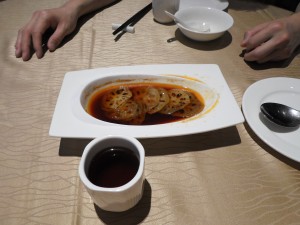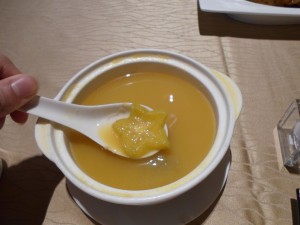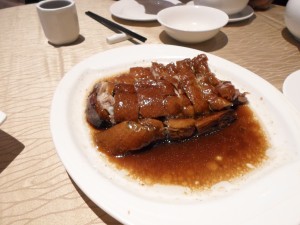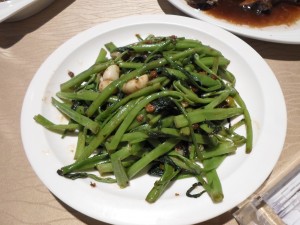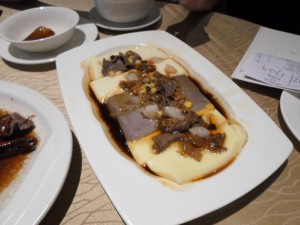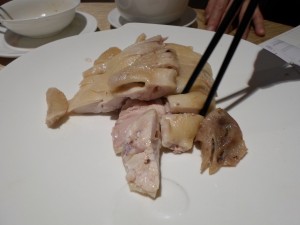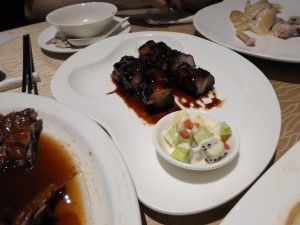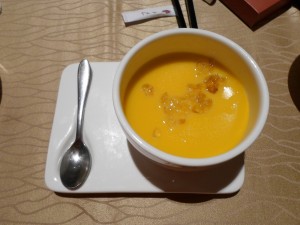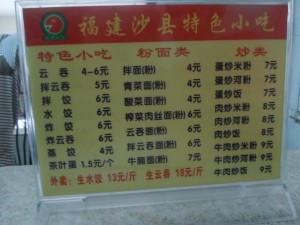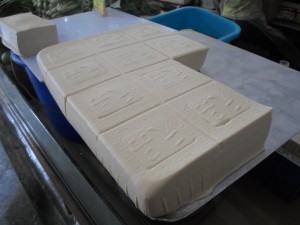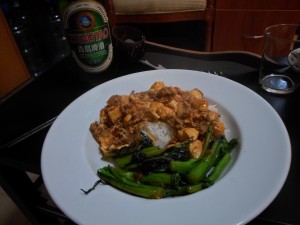As I mentioned before, Rachelle had a conference in Wuhan, and I was coming with her because I’m better than she is at exploring the Great Chinese Unknown. To get there, we decided to take the high-speed rail line, since it provided a nice balance between cost and time. In fact, it was the fastest (planes go faster, but are almost always delayed, not to mention the check-in and security procedures), and while more expensive than the slower trains, it would get us where we were going in about a third of the time.
It’s just after 5 AM and Rachelle and I are getting ready to catch an early train to Wuhan for a poetry conference she’s attending.
I’m not bringing the laptop, but I have a sick little notebook and a camera, and I’ll tell you all about it when we get back after Sunday night.
So, last Saurday there was a “Zumba party” at the Pilates studio. Basically this was a social/promotional event and there was food, drinks, and Zumba, as well as a demonstration of Pilates and Thai yoga. And of course, the zumba lady conscripted me to join for a few songs. Did I mention I’m really bad at those kinds of things? I can’t copy people’s movement on the fly, and I’m still pretty uncoordinated. I did eventually get the hang of it in the practice sessions, before people started showing up. If living in China is like an RPG (and despite what that link says, I think it’s also like a CRPG), then I just did the dancing minigame.
Even if Rigel hadn’t eaten our last good USB cord, there will be neither pictures nor video of this event.
Rachelle has uploaded and organized all our photos since 2009, which means I no longer have any excuses to not write some back-posts about our travels over the past half year or so.
But first, I have a Pilates class to teach.
With the return of hot, swampy weather comes a triumphant explosion in the local mosquito population. And apparently I’m the best thing on the menu. Yay?
One of the few luxuries we maintain here is a housekeeper who comes around for two hours on one of our busiest days (Wednesday, that is.) For about ten dollars, we can leave and get all our work done for the day and return to a clean apartment in the evening. This helps promote sanity and the continued health of our marriage. The floors will be mopped, the laundry hung up outside, the dishes washed…and this time of the year, the apartment will be full of mosquitoes. When we’re home, we try to ensure that no window or door to the outside is open for any longer than it absolutely needs to be. Mosquitoes will exploit any opportunity to get closer to a meal, after all. Our Ayi is a little less concerned about such things.
Last night, there was a particularly persistent mosquito (or a small swarm of less-motivated ones) buzzing around while I slept. I woke up looking like a plague victim, or perhaps an unfortunate teenager–swollen red splotches all over my face, and body, even a few on the soles of my feet. Rachelle managed to squash one against the wall, and it left a bloody smear the size of a quarter.
We have tried a few ways to mitigate this issue, but we currently don’t have mosquito netting, and keeping ourselves covered is just not feasible in this weather. We have a fan blowing across our bed as we sleep, and that seemed to work for a while, but I think they may have been evolving stronger wings lately. When Rachelle isn’t around, when I see a mosquito I just surround it with a cloud of Raid, but that’s not really a good long-term solution. Until we can get a better system to repel them, I may have to go to bed covered in bug repellent. Or, maybe I should just give up and slather myself in barbecue sauce for them.
By the time I leave China, I’ll either be completely immune to mosquito bites, or dead from malaria.
Oh, Rigel wanted to get in on the biting action too. Since he likes wind, when I blow on his face he’ll stretch himself out towards me and I’ll usually give him a kiss on the nose. Last night he decided he’d much rather try to bite my upper lip off. Time to consult the book of Armaments…
Rachelle wanted to make chicken salad, but we didn’t have pickles.
I used to make fun of her for saving every olive jar we ever had.
I don’t do that anymore.
A lot of things we take for granted back in the states are either super-expensive or nonexistent in China. For a while we could afford to get cheese and olives and tortillas and cans of beans and tomato sauce whenever we needed them. But as money gets tighter and our stateside bills become more and more burdensome, we first learned to do without, and when that sucked too much we figured out how to make our own. Tomato sauce, usually 39 cents a can back home, can go for over three dollars here in China. One day I brought back a large-ish sack of cherry tomatoes from the market and Rachelle decided she was going to make her own tomato sauce, as it is an imperative for making our favorite foods. This ended up being almost as cheap as an American can, and a little bit tastier to boot.
The pickles cost us perhaps about a dollar to make two jars (and we could have made more had we more available jars). A single jar at the imported foods market would cost us about 39 kuai, or over six dollars.
We still can’t make good cheese or nixtamalize our own corn for tortillas, so for the time being we have to reserve enchiladas as a special meal to treat our friends.
** Rachelle Says: “Alternate Titles of Post: A Pickle A Day Keeps the Ums at Bay; What A Pickle!; Pickle Me Tickle Me Too.”
I know that whenever I need some material for a post, I can always turn to something I’ve recently eaten. As any regular reader should know by now, there are all sorts of culinary adventures available for a foreigner in China. Recently, a friend of Rachelle’s and mine invited us out for an authentic Cantonese dinner at 炳胜(bing3 sheng4) restaurant across the street from the TaiKoo Hui shopping center.
We were going to take the B9 bus there, which uses Guangzhou’s BRT system–basically a highway for buses that cuts through the city and carries up to a million passengers a day. But apparently they had changed their plans and the one bus that stopped by was only going as far as Zhujiang New Town, so we gave up before the rain started falling too hard and took the metro, because hey, why not get packed in a rolling tin can like sardines.
We found the place rather easily, and our friend arrived shortly after. We let him make most of the choices, since we’re still not exactly experts on Cantonese cuisine, and in fact we can’t even speak Cantonese. Oh well.
In true Cantonese fashion, the dishes arrived as they were ready. We started out with some Pu’er tea, and marinated lotus root slices.
This tea comes from a particular part of Yunnan province and is fermented extensively, sometimes for decades. I don’t think our tea was quite that old, though. It is supposed to help digestion, especially of fatty or oily foods, and it had a delightful earthy taste. The lotus root marinade complemented it nicely, actually. For those who haven’t had lotus root before, it’s crispy and a little slippery and reminds me at least of a mix between water chestnut and raw potato. It’s also full of little holes, as you can see. Water plants love being hollow.
Next, the soup course.
So this soup had starfruit and papaya and pork. It was sweet and savory and quite good, although I didn’t end up finishing it before the next dish came out…
THE GOOSE. Rachelle and I love Cantonese goose. It took me a little while to be able to bite through the crispy skin, the layer of fat, and the meat all at once while still working around the bones (of course there’s bone, silly) and I still can’t not use my fingers a little to maneuver it around in my mouth, but still. Yum. You know, after that I could go for something lighter, maybe a vegetable or someth–
This veggie is called 通菜(tong1cai4), and in English has a few names, most commonly called water spinach. Here is is sauteed with garlic. I will keep an eye out for this one in the market.
This is three flavors of tofu, in sauce, and topped with beef and shrimp and whatnot. I didn’t notice a very strong difference in the flavors, although they all were good. Rachelle noted some differences, and said the dark one in the middle was kind of earthy and tea-like. This tofu was a lot creamier than the kind I usually get in the market, almost custard-like.
In Cantonese cuisine, chicken is done a little differently from how you might know it. First off, the head is often staring at you. It’s also very lightly seasoned, if at all. Cantonese cuisine is all about the natural flavors of components, and so on. Sometimes this leads to terribly bland foods, but the natural taste of a chicken that isn’t stuck in a battery cage and fattened with corn and chemicals is actually quite delicious. This actually came with a little bowl of garlic dipping sauce, which was also great, but I mostly ate it plain. By this point, I was pretty sure that was all there was to the meal.
But then the pork arrived. And wow. It had a lot of fat, which is a feature it took me a while to get used to in food around here, but once you get used to it, you can enjoy food like this. The glaze on it was sticky, and slightly sweet, and just…well it made me happy to eat it. Okay. That was the meal.
Wait, dessert.
This is a pumpkin soup. There’s some stuff we think is tapioca on top. It was a perfect end to the meal.
Fuck yeah. Also, that’s another person we’re gonna make enchiladas for.
So of course Rachelle and I went to the Shaxian Snacks place outside Xiaogang Park the other day (it’s our favorite one) and this time we had some kick-ass 云吞汤, or wonton soup if you aren’t trying to be a douche like me. Add to that a heaping plate of fried noodles’n'eggs (I forgot what the actual name for it was, but asking for 鸡蛋炒面 – ji1 dan4 chao3 mian4 – got the point across) and, at the older lady manning the counter’s insistence, a surprisingly tasty black chicken and ginseng soup, whose menu entry claims it has medicinal properties, and we had filled our bellies for around 20 kuai.
But I already talked about those cheap eats. Another way to get food without spending much money is to have many Chinese friends, and to talk to them often. Before long, you will be invited to lunch or dinner, and they will almost always insist on paying the tab, and you will usually get to discover some new place to eat which you otherwise would never have known about. And thus begins my first taste of the dining phenomenon known as “Hot Pot.”
Of course I had heard about hot pot, I had seen people eating it, I had heard it was a wonderful experience, but until that day I had never tried it. It just seemed too daunting to try something so new, in a language I was still quite unfamiliar with, without any kind of guide. One of Rachelle’s colleagues, who was also her workout buddy and good friend, invited us to hot pot with her and her husband. Fuck yeah hot pot. So we met near the gym (a short bus ride from campus) and all piled into a cab headed for the outlet mall which housed our dining destination.
I offered to be a good guest and pay the cab fare (only ten kuai) but our friends wouldn’t hear of it, and besides, cabbies and other service personnel will try their damnedest not to acknowledge a foreigner if there is a Chinese person in the group. I have been told this is the case even if the “Chinese” person is American, or Japanese, and actually speaks no Chinese, and the foreigner is near-fluent, and this leads to all manner of frustration for all involved. But I digress.
The restaurant had an English name under the Chinese, “Cool and Hot Cooking Pot.” The gimmick here was that there were actually two cooking areas to a table. Most hot pot restaurants have a well for the eponymous pot to sit in and boil, but this one also had a flat barbecue well, which was kept well-supplied with a steady stream of marinated fish, meats, squid bits, and other marvelous things. One tasty, oily fish was explained to us as being called “Korean Fish.” Nobody had a very good reason as to why, so I ventured that it looked a little like Kim Jong-un, and everyone had a good laugh. Except for Kim Jong-un.
Hot pot itself is pretty simple. They give you thin little pieces of meat (sometimes with lots of cartilage, which while not particularly desirable in the States is a nom-a-minute here in China) and you drop it into the broth, which in our case was divided into a clear, light broth and a spicy Sichuan one. There are many other things you can put into the pot – it’s kind of like Chinese fondue, really – and this restaurant had a whole buffet of various things and meats and fish slices and mushrooms and veggies and unidentifiable other things that I was told are certainly delicacies in China…
By the time we were finished, I’m pretty sure I had gained a few pounds and my stride had been reduced to a waddle.
Oh, and for the friend food to be viable and for you to not seem like an asshole it goes without saying that you must genuinely be a good friend and from time to time treat them in return when finances allow. In this case, since these particular friends have spent time in America and enjoy Mexican food, we plan to have them over for Rachelle’s home-cooked enchiladas, which are pretty much one of the best things you can give someone you like.
BUNNY UPDATE: He really loves the fan. We moved it and he found a chair nearby to jump onto so he could feel the wind in his face. Maybe it feels like he’s running really fast.
OTHER UPDATE: Hey, just about everyone in China uses the QQ messenger, and now I do too. But I don’t have any QQ friends yet. If you want to try it, add 1354161861, because that’s me.
So as you may know, our budget has been a little tight lately. Fortunately, food can be obtained for cheap all over Guangzhou, if you know what to look for. One of the best cheap/yummy combinations is the Shaxian Snacks branded restaurants.
As the story goes, Sha county (xian) in Fujian province is a very poor area with really tasty variations of common Chinese munchies– dumplings, noodles, won tons, etc. etc. And when a man from that area opened a couple snack bars in a major city, they were an instant hit and since trademarks aren’t really a big thing in China, everyone started opening them. There’s a county government “Snacks Bureau” which apparently tries to maintain a standard of quality for all the restaurants bearing its name. I can’t imagine it’s easy, because there are freaking hundreds of these places in Guangzhou alone. Someone even came up with a story to explain the real reason there are so many, if you can read Chinese or don’t mind Google’s machine translation.
Anyway, all you have to do is look for the red Pac-man looking logo with the words “Shaxian Delicacies” around it, and be able to recognize a few characters, and you too can get some cheap noms!
As you can see from the menu, just about everything is very cheap, averaging maybe $1 per dish. They’re filling, and delicious, and this one, being close to the student dorms at SYSU, is very popular with students. And me.
And yes, that green stuff is, in fact, cooked lettuce. And strange as it may seem to most Westerners, it’s fucking delicious. Anyway, thanks to this place, I can fill my stomach for around 12 kuai (about 2 dollars perhaps?) and if I somehow have room for more food, there’s usually a Muslim guy selling barbecued meat skewers right across the street for 3-5 kuai, depending on what kind of meat you get.
Sometimes, though, you don’t want to go to a restaurant. You want the comforts of home. But you also want delicious Sichuan food. I thought this was a problem, until I found a packet of Mapo Doufu sauce (enough for two dinners) at a nearby grocery store. If I recall correctly, it cost about 5 kuai. All you need is some water, minced/ground pork/beef (the pork was about 7 kuai for enough for two dinners), and then when I was ready to make it, I headed down to the neighborhood wet market and picked up some fresh bean-curdy goodness.
So one of those squares is enough to make one dinner for two people, although it might be slightly less than the packet calls for. Either way, it’s 2 kuai a pop. Follow the packet instructions, fill up the rice maker, saute up some cai xin on the side, and voila!
I’ve already touched on the raininess of spring in Guangzhou. This place makes Pittsburgh look sunny at this time of year (and we all know Pittsburgh is the Seattle of the East as far as gloom is concerned). Of course, it’s also relatively warm, which leads to 89-90% humidity being the norm. This means that nothing ever gets dry. We generally hang laundry on the balcony, since we (and most Chinese) do not have a dryer, and during most of the year so far, this has worked fine. But it’s far too humid and not nearly hot enough for anything to dry, and so after three to five days of hanging outside, our clothes are no drier than when we put them there, and smell somewhat of mildew. Everything starts smelling like mildew and funk in this humidity.
So, I brought the laundry rack back inside. I put two of our dehumidifiers underneath it (being careful to hide the cords from hungry bunny teeth) and set up the fan to keep air flowing constantly through the setup. It seems to be working for the time being. If only I could take advantage of the air conditioner without making it freezing in here…or jacking our power bill through the roof.
I’m really glad I brought my waterproof boots.

